Holmes Institute HI6026 Audit and Assurance: Legal Liability
VerifiedAdded on 2023/01/20
|17
|4319
|70
Report
AI Summary
This report examines the legal liability of auditors through a case study, focusing on the 'Royal Bank of Scotland vs Bannerman Johnston Maclay' case. It explores the auditor's responsibilities, the impact of professional negligence on third parties, and the root causes of the issue, including audit scope limitations and material misstatements. The report delves into the court's decision, emphasizing the auditor's duty of care towards third parties who rely on financial statements. It analyzes the penalties imposed and discusses the implications of accounting standards. Furthermore, the report provides recommendations for improving audit strategies, planning, and minimizing litigation risks, ensuring professional integrity and reputation. This detailed analysis helps students understand the complexities of audit and assurance in the context of legal liability, offering valuable insights for their academic pursuits. The report underscores the importance of thorough auditing processes to maintain financial statement accuracy and protect stakeholders.
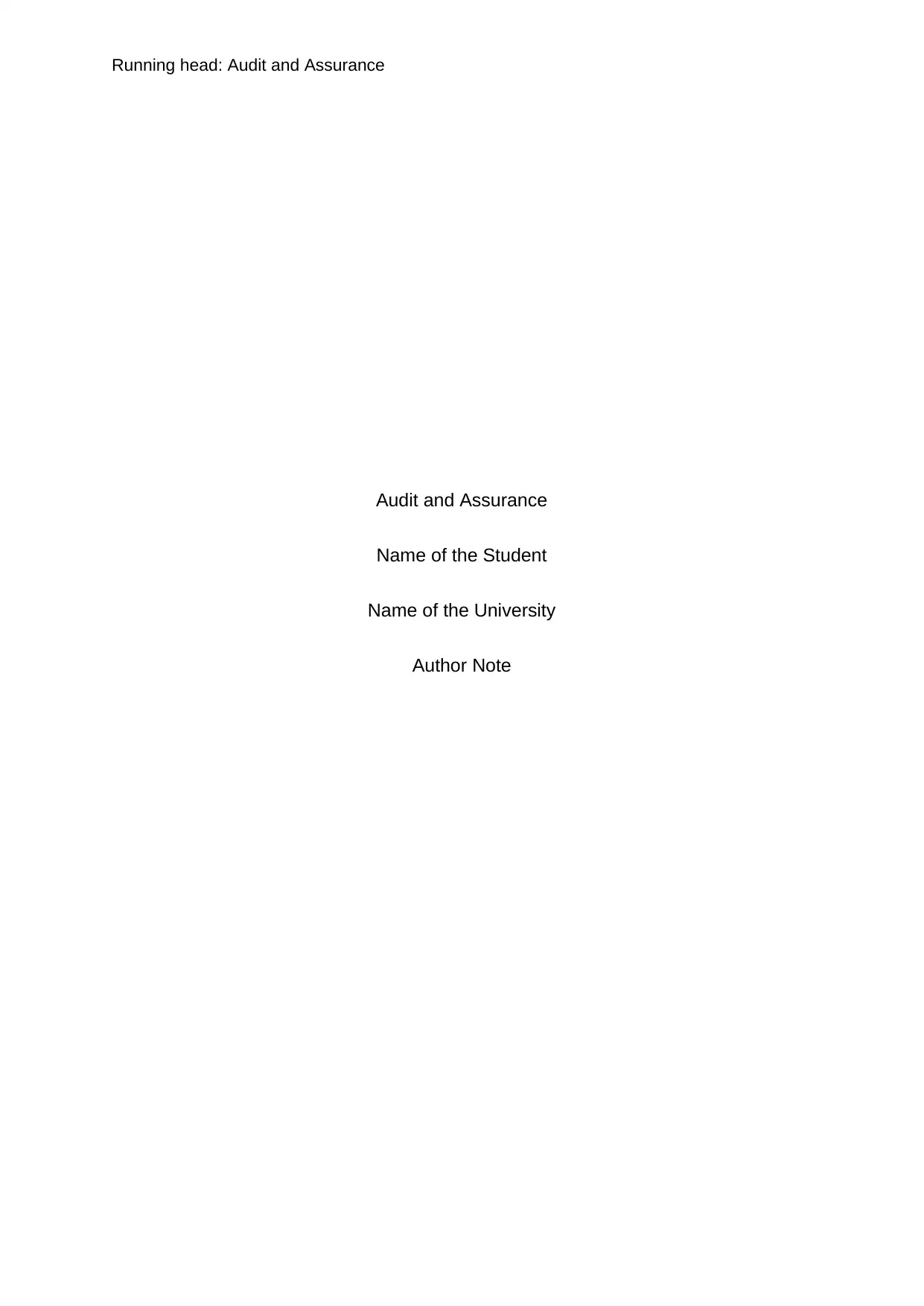
Running head: Audit and Assurance
Audit and Assurance
Name of the Student
Name of the University
Author Note
Audit and Assurance
Name of the Student
Name of the University
Author Note
Paraphrase This Document
Need a fresh take? Get an instant paraphrase of this document with our AI Paraphraser
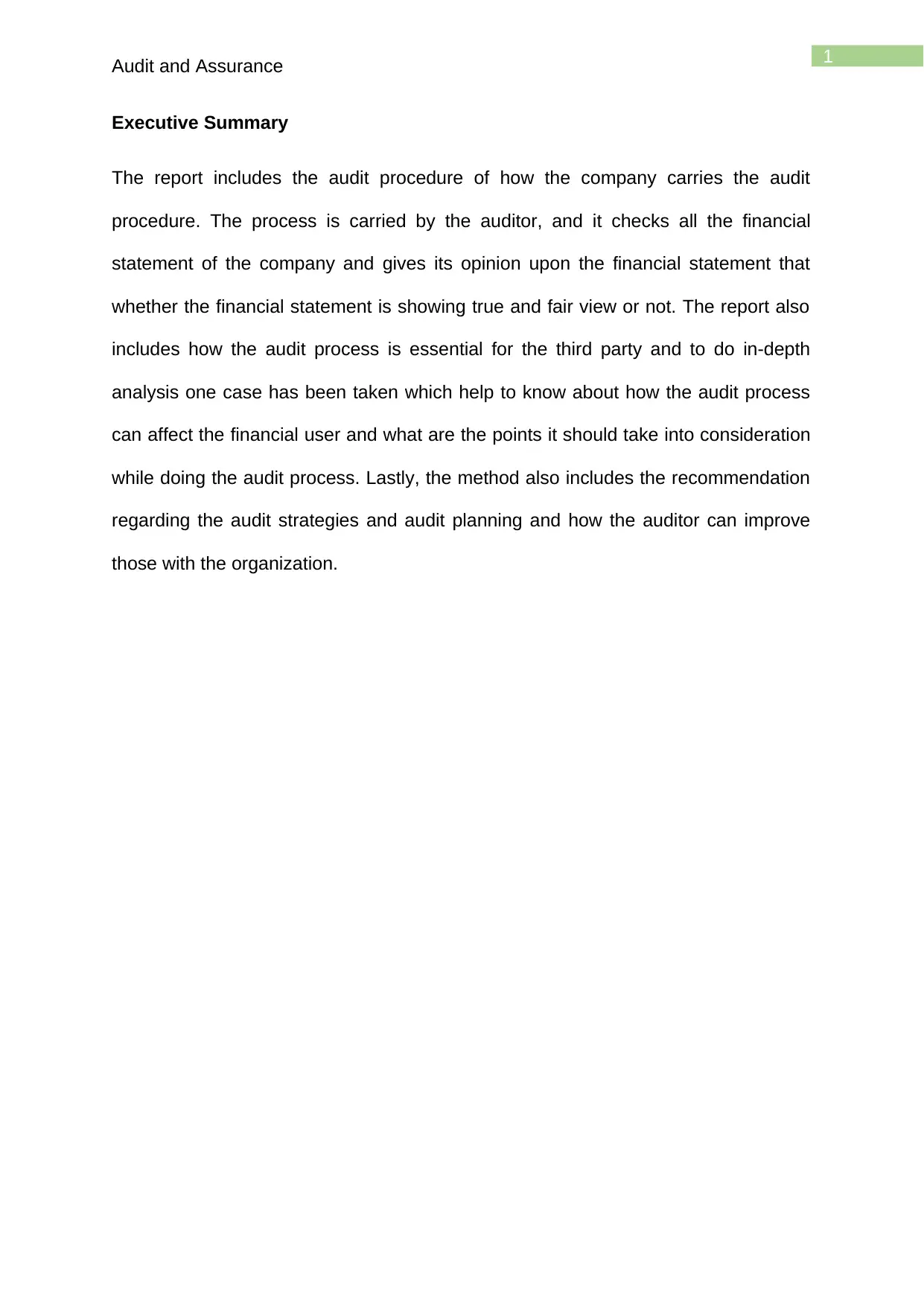
1
Audit and Assurance
Executive Summary
The report includes the audit procedure of how the company carries the audit
procedure. The process is carried by the auditor, and it checks all the financial
statement of the company and gives its opinion upon the financial statement that
whether the financial statement is showing true and fair view or not. The report also
includes how the audit process is essential for the third party and to do in-depth
analysis one case has been taken which help to know about how the audit process
can affect the financial user and what are the points it should take into consideration
while doing the audit process. Lastly, the method also includes the recommendation
regarding the audit strategies and audit planning and how the auditor can improve
those with the organization.
Audit and Assurance
Executive Summary
The report includes the audit procedure of how the company carries the audit
procedure. The process is carried by the auditor, and it checks all the financial
statement of the company and gives its opinion upon the financial statement that
whether the financial statement is showing true and fair view or not. The report also
includes how the audit process is essential for the third party and to do in-depth
analysis one case has been taken which help to know about how the audit process
can affect the financial user and what are the points it should take into consideration
while doing the audit process. Lastly, the method also includes the recommendation
regarding the audit strategies and audit planning and how the auditor can improve
those with the organization.
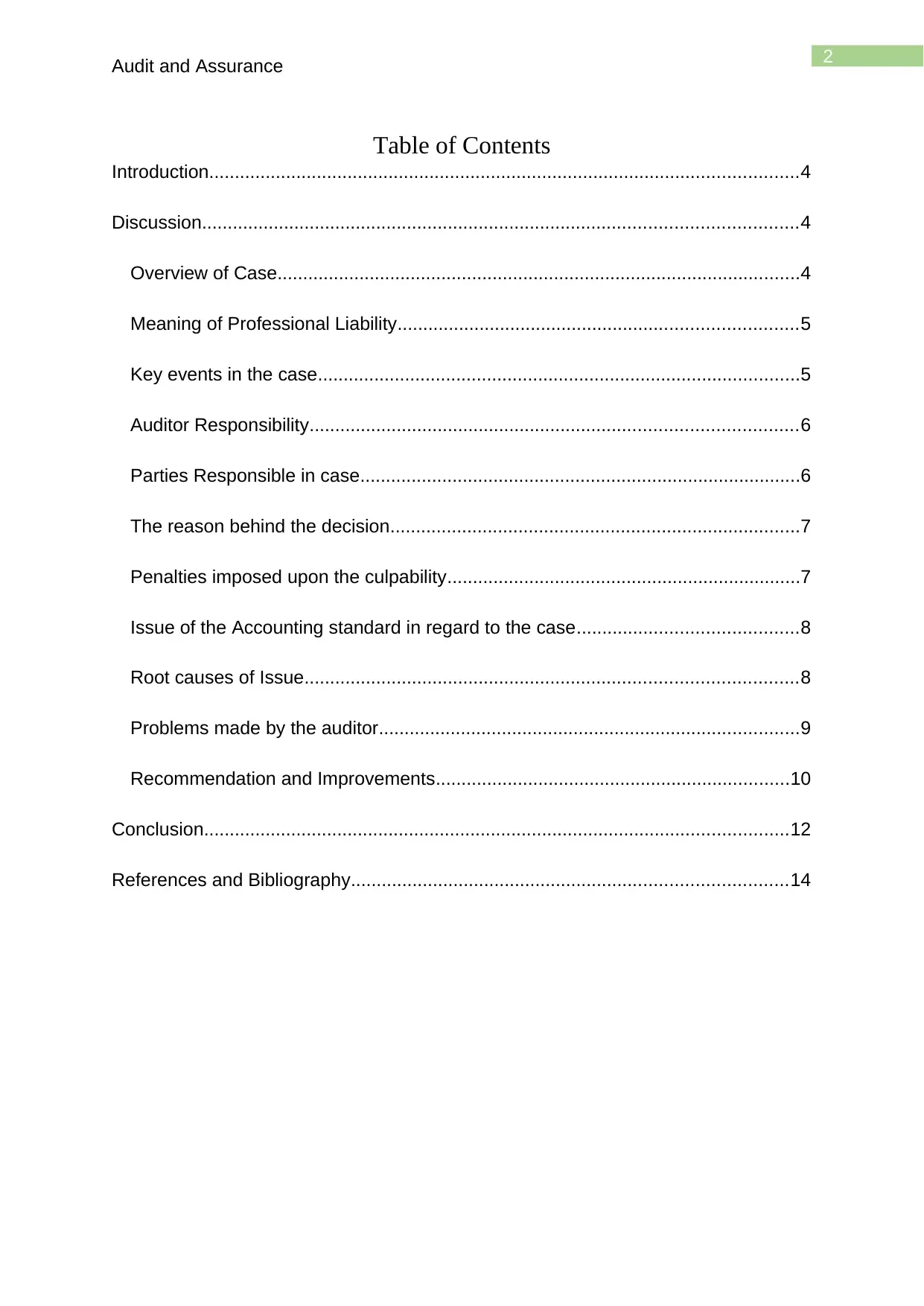
2
Audit and Assurance
Table of Contents
Introduction...................................................................................................................4
Discussion....................................................................................................................4
Overview of Case......................................................................................................4
Meaning of Professional Liability..............................................................................5
Key events in the case..............................................................................................5
Auditor Responsibility...............................................................................................6
Parties Responsible in case......................................................................................6
The reason behind the decision................................................................................7
Penalties imposed upon the culpability.....................................................................7
Issue of the Accounting standard in regard to the case...........................................8
Root causes of Issue................................................................................................8
Problems made by the auditor..................................................................................9
Recommendation and Improvements.....................................................................10
Conclusion..................................................................................................................12
References and Bibliography.....................................................................................14
Audit and Assurance
Table of Contents
Introduction...................................................................................................................4
Discussion....................................................................................................................4
Overview of Case......................................................................................................4
Meaning of Professional Liability..............................................................................5
Key events in the case..............................................................................................5
Auditor Responsibility...............................................................................................6
Parties Responsible in case......................................................................................6
The reason behind the decision................................................................................7
Penalties imposed upon the culpability.....................................................................7
Issue of the Accounting standard in regard to the case...........................................8
Root causes of Issue................................................................................................8
Problems made by the auditor..................................................................................9
Recommendation and Improvements.....................................................................10
Conclusion..................................................................................................................12
References and Bibliography.....................................................................................14
⊘ This is a preview!⊘
Do you want full access?
Subscribe today to unlock all pages.

Trusted by 1+ million students worldwide

3
Audit and Assurance
Introduction
An audit is the examination and inspection of the financial books of the company. It
is the process in which the fairness of the financial statement is checked. The
method of auditing carried by both internal as well as an external person. If the audit
process is sent by an inner person than it is said to be internal audit under this the
person check whether all the control is working correctly or not (Ahmed Haji and
Anifowose 2016). It checks the internal control of the management to ensure that all
the management process is carried successfully in the organization. If the external
person does the audit than he is called auditor and the process is called statutory
auditor. In this, the auditor checks all financial books of the company and give an
opinion regarding whether the financial statement is showing accurate and fair view
or not (Barker and Branson 2014). Compliance means how the company comply
with the rules and regulation related to the industry norms. It is how the company
manage all the requirement of law and another standard upon the business of the
company. Auditor also checks whether the company had complied with all the law
and other regulation related to the financial statement and how they have treated
them in the financial reports (Bell, Causholli and Knechel 2015). It also helps to
ensure that the balance sheet made with all the standard and rules related to the
international accounting standard.
Discussion
Overview of the Case
` The report is based upon the importance of professional liability related to the
auditor, and to understand the topic the case study which is "Royal Bank of Scotland
vs Bannerman Johnston Maclay". The case is related to the auditor is not able to
Audit and Assurance
Introduction
An audit is the examination and inspection of the financial books of the company. It
is the process in which the fairness of the financial statement is checked. The
method of auditing carried by both internal as well as an external person. If the audit
process is sent by an inner person than it is said to be internal audit under this the
person check whether all the control is working correctly or not (Ahmed Haji and
Anifowose 2016). It checks the internal control of the management to ensure that all
the management process is carried successfully in the organization. If the external
person does the audit than he is called auditor and the process is called statutory
auditor. In this, the auditor checks all financial books of the company and give an
opinion regarding whether the financial statement is showing accurate and fair view
or not (Barker and Branson 2014). Compliance means how the company comply
with the rules and regulation related to the industry norms. It is how the company
manage all the requirement of law and another standard upon the business of the
company. Auditor also checks whether the company had complied with all the law
and other regulation related to the financial statement and how they have treated
them in the financial reports (Bell, Causholli and Knechel 2015). It also helps to
ensure that the balance sheet made with all the standard and rules related to the
international accounting standard.
Discussion
Overview of the Case
` The report is based upon the importance of professional liability related to the
auditor, and to understand the topic the case study which is "Royal Bank of Scotland
vs Bannerman Johnston Maclay". The case is related to the auditor is not able to
Paraphrase This Document
Need a fresh take? Get an instant paraphrase of this document with our AI Paraphraser
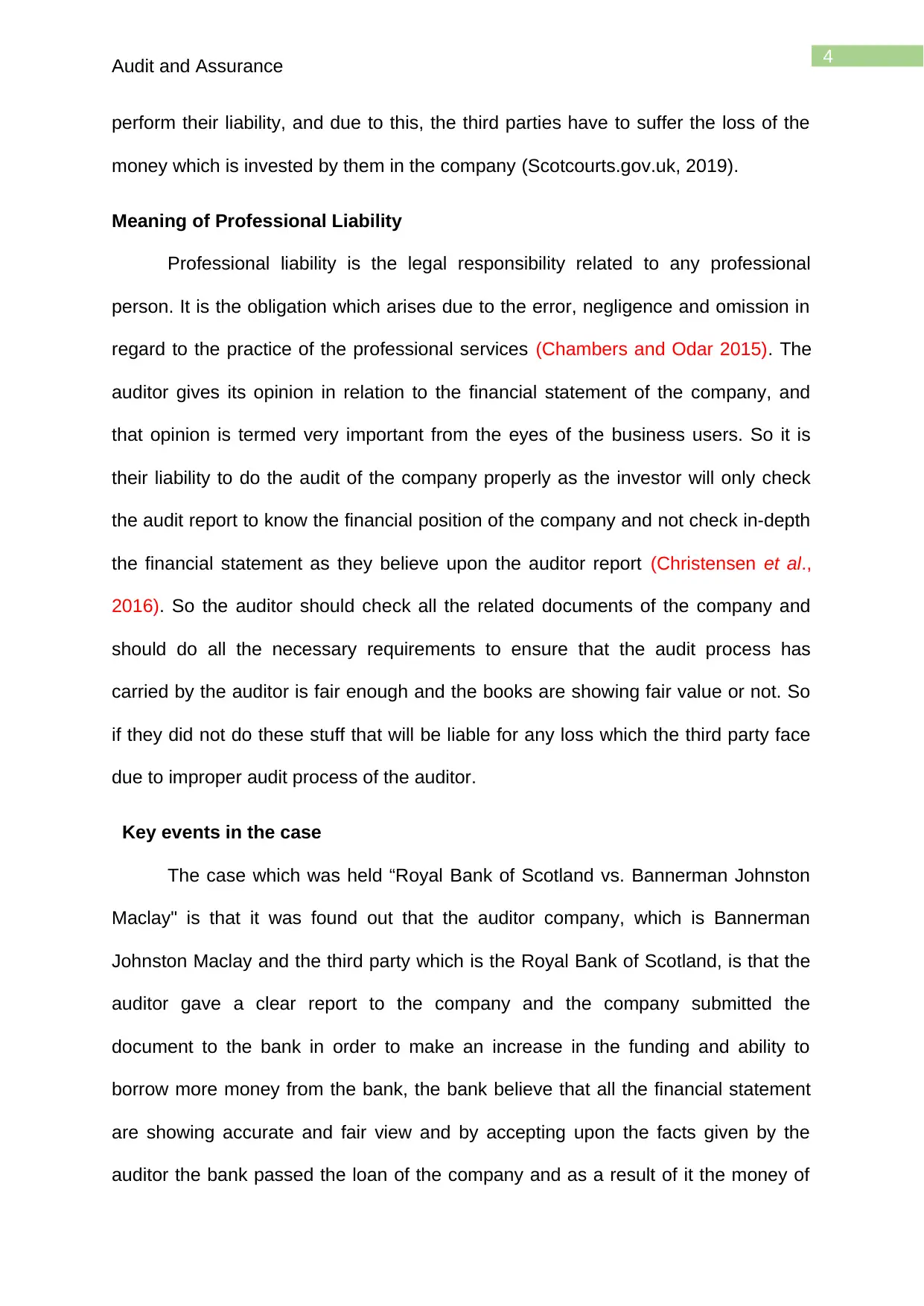
4
Audit and Assurance
perform their liability, and due to this, the third parties have to suffer the loss of the
money which is invested by them in the company (Scotcourts.gov.uk, 2019).
Meaning of Professional Liability
Professional liability is the legal responsibility related to any professional
person. It is the obligation which arises due to the error, negligence and omission in
regard to the practice of the professional services (Chambers and Odar 2015). The
auditor gives its opinion in relation to the financial statement of the company, and
that opinion is termed very important from the eyes of the business users. So it is
their liability to do the audit of the company properly as the investor will only check
the audit report to know the financial position of the company and not check in-depth
the financial statement as they believe upon the auditor report (Christensen et al.,
2016). So the auditor should check all the related documents of the company and
should do all the necessary requirements to ensure that the audit process has
carried by the auditor is fair enough and the books are showing fair value or not. So
if they did not do these stuff that will be liable for any loss which the third party face
due to improper audit process of the auditor.
Key events in the case
The case which was held “Royal Bank of Scotland vs. Bannerman Johnston
Maclay" is that it was found out that the auditor company, which is Bannerman
Johnston Maclay and the third party which is the Royal Bank of Scotland, is that the
auditor gave a clear report to the company and the company submitted the
document to the bank in order to make an increase in the funding and ability to
borrow more money from the bank, the bank believe that all the financial statement
are showing accurate and fair view and by accepting upon the facts given by the
auditor the bank passed the loan of the company and as a result of it the money of
Audit and Assurance
perform their liability, and due to this, the third parties have to suffer the loss of the
money which is invested by them in the company (Scotcourts.gov.uk, 2019).
Meaning of Professional Liability
Professional liability is the legal responsibility related to any professional
person. It is the obligation which arises due to the error, negligence and omission in
regard to the practice of the professional services (Chambers and Odar 2015). The
auditor gives its opinion in relation to the financial statement of the company, and
that opinion is termed very important from the eyes of the business users. So it is
their liability to do the audit of the company properly as the investor will only check
the audit report to know the financial position of the company and not check in-depth
the financial statement as they believe upon the auditor report (Christensen et al.,
2016). So the auditor should check all the related documents of the company and
should do all the necessary requirements to ensure that the audit process has
carried by the auditor is fair enough and the books are showing fair value or not. So
if they did not do these stuff that will be liable for any loss which the third party face
due to improper audit process of the auditor.
Key events in the case
The case which was held “Royal Bank of Scotland vs. Bannerman Johnston
Maclay" is that it was found out that the auditor company, which is Bannerman
Johnston Maclay and the third party which is the Royal Bank of Scotland, is that the
auditor gave a clear report to the company and the company submitted the
document to the bank in order to make an increase in the funding and ability to
borrow more money from the bank, the bank believe that all the financial statement
are showing accurate and fair view and by accepting upon the facts given by the
auditor the bank passed the loan of the company and as a result of it the money of
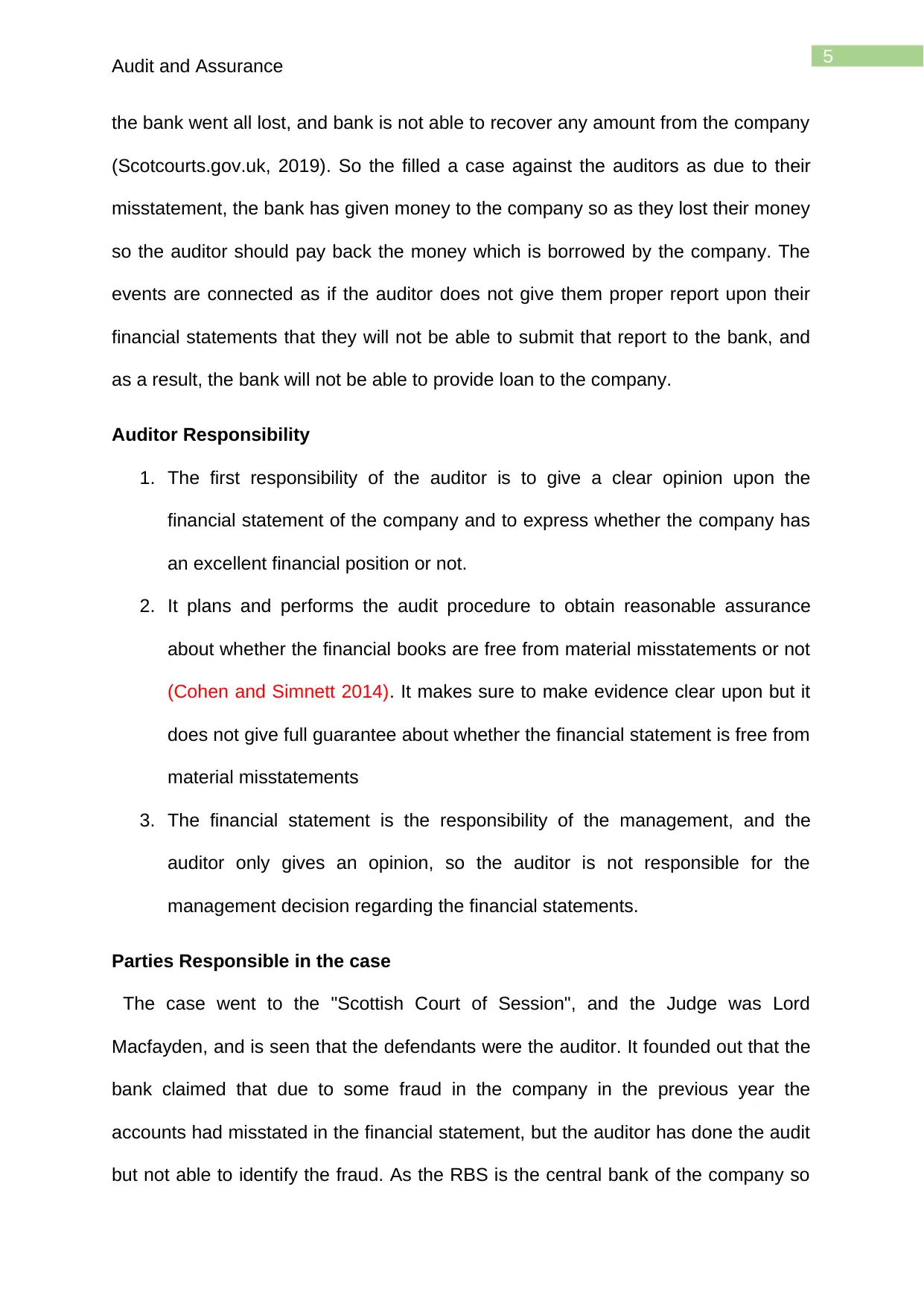
5
Audit and Assurance
the bank went all lost, and bank is not able to recover any amount from the company
(Scotcourts.gov.uk, 2019). So the filled a case against the auditors as due to their
misstatement, the bank has given money to the company so as they lost their money
so the auditor should pay back the money which is borrowed by the company. The
events are connected as if the auditor does not give them proper report upon their
financial statements that they will not be able to submit that report to the bank, and
as a result, the bank will not be able to provide loan to the company.
Auditor Responsibility
1. The first responsibility of the auditor is to give a clear opinion upon the
financial statement of the company and to express whether the company has
an excellent financial position or not.
2. It plans and performs the audit procedure to obtain reasonable assurance
about whether the financial books are free from material misstatements or not
(Cohen and Simnett 2014). It makes sure to make evidence clear upon but it
does not give full guarantee about whether the financial statement is free from
material misstatements
3. The financial statement is the responsibility of the management, and the
auditor only gives an opinion, so the auditor is not responsible for the
management decision regarding the financial statements.
Parties Responsible in the case
The case went to the "Scottish Court of Session", and the Judge was Lord
Macfayden, and is seen that the defendants were the auditor. It founded out that the
bank claimed that due to some fraud in the company in the previous year the
accounts had misstated in the financial statement, but the auditor has done the audit
but not able to identify the fraud. As the RBS is the central bank of the company so
Audit and Assurance
the bank went all lost, and bank is not able to recover any amount from the company
(Scotcourts.gov.uk, 2019). So the filled a case against the auditors as due to their
misstatement, the bank has given money to the company so as they lost their money
so the auditor should pay back the money which is borrowed by the company. The
events are connected as if the auditor does not give them proper report upon their
financial statements that they will not be able to submit that report to the bank, and
as a result, the bank will not be able to provide loan to the company.
Auditor Responsibility
1. The first responsibility of the auditor is to give a clear opinion upon the
financial statement of the company and to express whether the company has
an excellent financial position or not.
2. It plans and performs the audit procedure to obtain reasonable assurance
about whether the financial books are free from material misstatements or not
(Cohen and Simnett 2014). It makes sure to make evidence clear upon but it
does not give full guarantee about whether the financial statement is free from
material misstatements
3. The financial statement is the responsibility of the management, and the
auditor only gives an opinion, so the auditor is not responsible for the
management decision regarding the financial statements.
Parties Responsible in the case
The case went to the "Scottish Court of Session", and the Judge was Lord
Macfayden, and is seen that the defendants were the auditor. It founded out that the
bank claimed that due to some fraud in the company in the previous year the
accounts had misstated in the financial statement, but the auditor has done the audit
but not able to identify the fraud. As the RBS is the central bank of the company so
⊘ This is a preview!⊘
Do you want full access?
Subscribe today to unlock all pages.

Trusted by 1+ million students worldwide
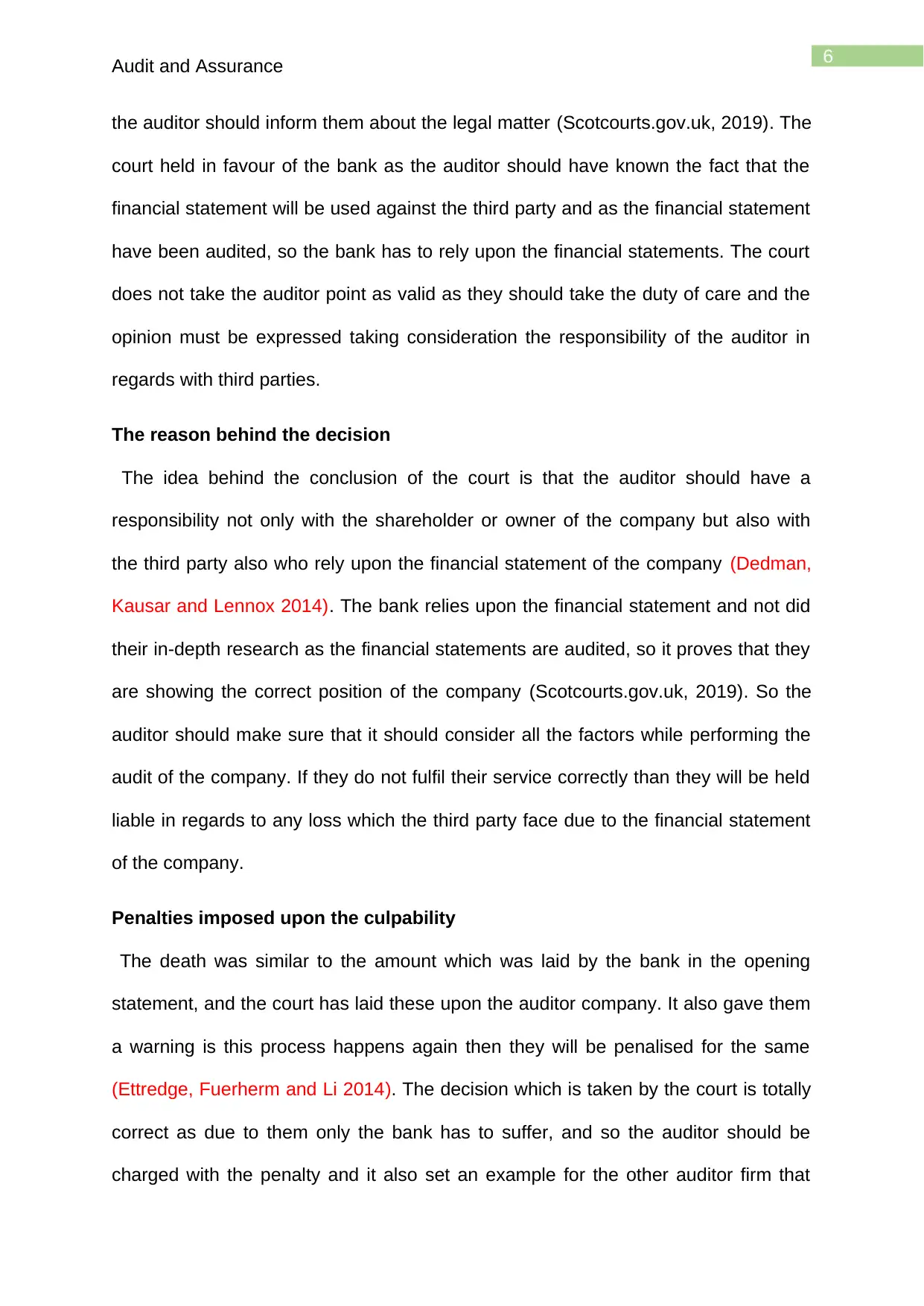
6
Audit and Assurance
the auditor should inform them about the legal matter (Scotcourts.gov.uk, 2019). The
court held in favour of the bank as the auditor should have known the fact that the
financial statement will be used against the third party and as the financial statement
have been audited, so the bank has to rely upon the financial statements. The court
does not take the auditor point as valid as they should take the duty of care and the
opinion must be expressed taking consideration the responsibility of the auditor in
regards with third parties.
The reason behind the decision
The idea behind the conclusion of the court is that the auditor should have a
responsibility not only with the shareholder or owner of the company but also with
the third party also who rely upon the financial statement of the company (Dedman,
Kausar and Lennox 2014). The bank relies upon the financial statement and not did
their in-depth research as the financial statements are audited, so it proves that they
are showing the correct position of the company (Scotcourts.gov.uk, 2019). So the
auditor should make sure that it should consider all the factors while performing the
audit of the company. If they do not fulfil their service correctly than they will be held
liable in regards to any loss which the third party face due to the financial statement
of the company.
Penalties imposed upon the culpability
The death was similar to the amount which was laid by the bank in the opening
statement, and the court has laid these upon the auditor company. It also gave them
a warning is this process happens again then they will be penalised for the same
(Ettredge, Fuerherm and Li 2014). The decision which is taken by the court is totally
correct as due to them only the bank has to suffer, and so the auditor should be
charged with the penalty and it also set an example for the other auditor firm that
Audit and Assurance
the auditor should inform them about the legal matter (Scotcourts.gov.uk, 2019). The
court held in favour of the bank as the auditor should have known the fact that the
financial statement will be used against the third party and as the financial statement
have been audited, so the bank has to rely upon the financial statements. The court
does not take the auditor point as valid as they should take the duty of care and the
opinion must be expressed taking consideration the responsibility of the auditor in
regards with third parties.
The reason behind the decision
The idea behind the conclusion of the court is that the auditor should have a
responsibility not only with the shareholder or owner of the company but also with
the third party also who rely upon the financial statement of the company (Dedman,
Kausar and Lennox 2014). The bank relies upon the financial statement and not did
their in-depth research as the financial statements are audited, so it proves that they
are showing the correct position of the company (Scotcourts.gov.uk, 2019). So the
auditor should make sure that it should consider all the factors while performing the
audit of the company. If they do not fulfil their service correctly than they will be held
liable in regards to any loss which the third party face due to the financial statement
of the company.
Penalties imposed upon the culpability
The death was similar to the amount which was laid by the bank in the opening
statement, and the court has laid these upon the auditor company. It also gave them
a warning is this process happens again then they will be penalised for the same
(Ettredge, Fuerherm and Li 2014). The decision which is taken by the court is totally
correct as due to them only the bank has to suffer, and so the auditor should be
charged with the penalty and it also set an example for the other auditor firm that
Paraphrase This Document
Need a fresh take? Get an instant paraphrase of this document with our AI Paraphraser
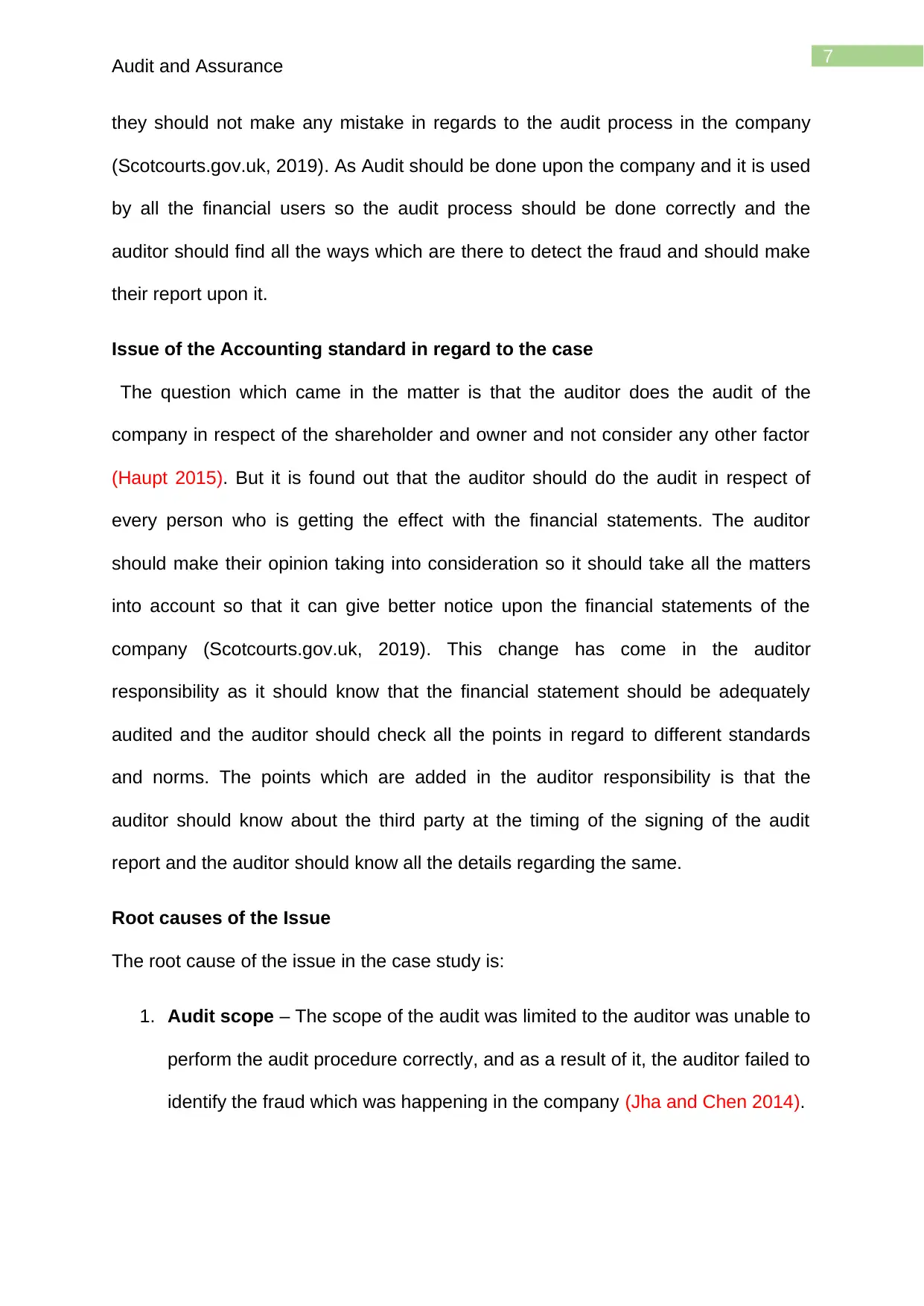
7
Audit and Assurance
they should not make any mistake in regards to the audit process in the company
(Scotcourts.gov.uk, 2019). As Audit should be done upon the company and it is used
by all the financial users so the audit process should be done correctly and the
auditor should find all the ways which are there to detect the fraud and should make
their report upon it.
Issue of the Accounting standard in regard to the case
The question which came in the matter is that the auditor does the audit of the
company in respect of the shareholder and owner and not consider any other factor
(Haupt 2015). But it is found out that the auditor should do the audit in respect of
every person who is getting the effect with the financial statements. The auditor
should make their opinion taking into consideration so it should take all the matters
into account so that it can give better notice upon the financial statements of the
company (Scotcourts.gov.uk, 2019). This change has come in the auditor
responsibility as it should know that the financial statement should be adequately
audited and the auditor should check all the points in regard to different standards
and norms. The points which are added in the auditor responsibility is that the
auditor should know about the third party at the timing of the signing of the audit
report and the auditor should know all the details regarding the same.
Root causes of the Issue
The root cause of the issue in the case study is:
1. Audit scope – The scope of the audit was limited to the auditor was unable to
perform the audit procedure correctly, and as a result of it, the auditor failed to
identify the fraud which was happening in the company (Jha and Chen 2014).
Audit and Assurance
they should not make any mistake in regards to the audit process in the company
(Scotcourts.gov.uk, 2019). As Audit should be done upon the company and it is used
by all the financial users so the audit process should be done correctly and the
auditor should find all the ways which are there to detect the fraud and should make
their report upon it.
Issue of the Accounting standard in regard to the case
The question which came in the matter is that the auditor does the audit of the
company in respect of the shareholder and owner and not consider any other factor
(Haupt 2015). But it is found out that the auditor should do the audit in respect of
every person who is getting the effect with the financial statements. The auditor
should make their opinion taking into consideration so it should take all the matters
into account so that it can give better notice upon the financial statements of the
company (Scotcourts.gov.uk, 2019). This change has come in the auditor
responsibility as it should know that the financial statement should be adequately
audited and the auditor should check all the points in regard to different standards
and norms. The points which are added in the auditor responsibility is that the
auditor should know about the third party at the timing of the signing of the audit
report and the auditor should know all the details regarding the same.
Root causes of the Issue
The root cause of the issue in the case study is:
1. Audit scope – The scope of the audit was limited to the auditor was unable to
perform the audit procedure correctly, and as a result of it, the auditor failed to
identify the fraud which was happening in the company (Jha and Chen 2014).
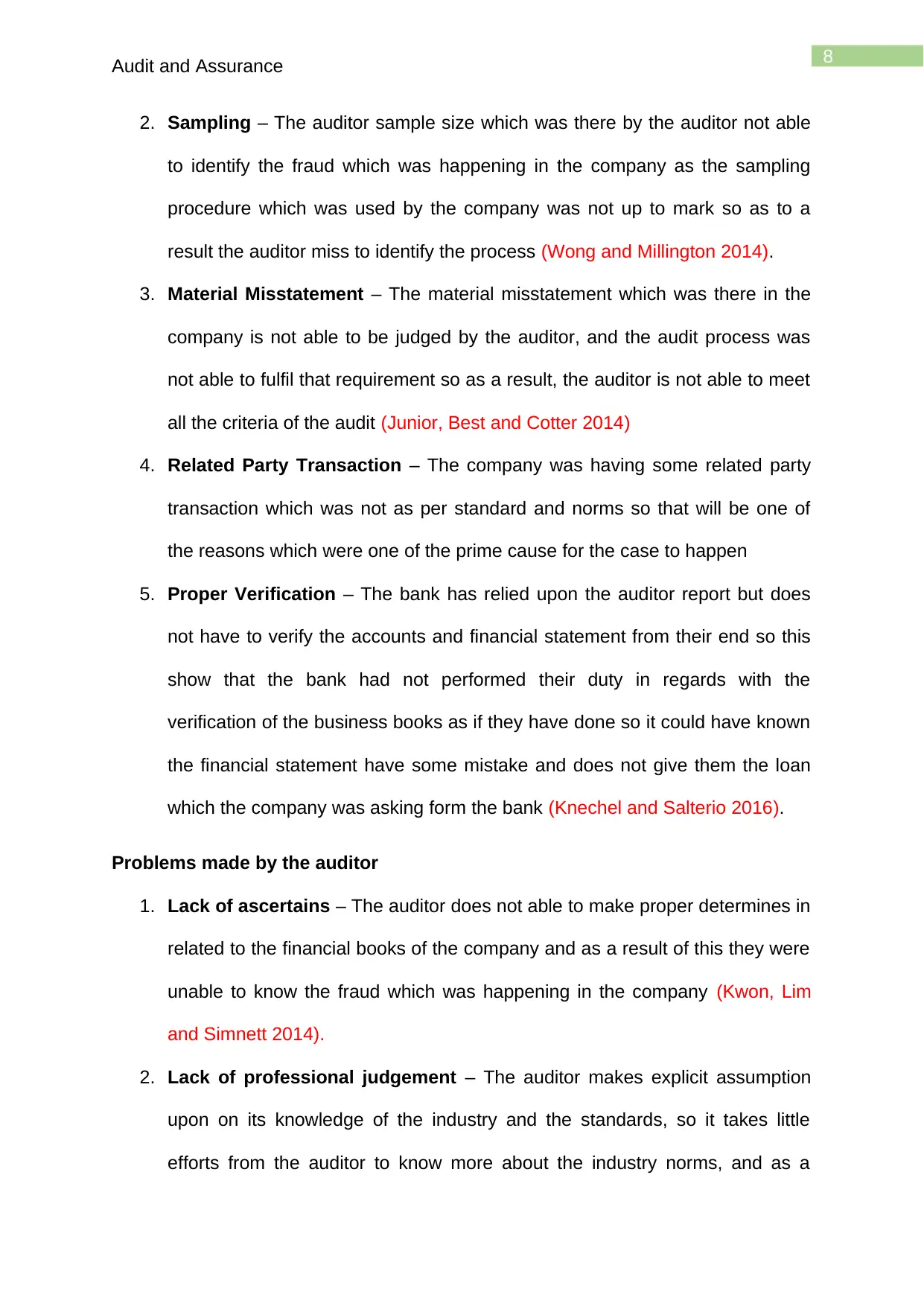
8
Audit and Assurance
2. Sampling – The auditor sample size which was there by the auditor not able
to identify the fraud which was happening in the company as the sampling
procedure which was used by the company was not up to mark so as to a
result the auditor miss to identify the process (Wong and Millington 2014).
3. Material Misstatement – The material misstatement which was there in the
company is not able to be judged by the auditor, and the audit process was
not able to fulfil that requirement so as a result, the auditor is not able to meet
all the criteria of the audit (Junior, Best and Cotter 2014)
4. Related Party Transaction – The company was having some related party
transaction which was not as per standard and norms so that will be one of
the reasons which were one of the prime cause for the case to happen
5. Proper Verification – The bank has relied upon the auditor report but does
not have to verify the accounts and financial statement from their end so this
show that the bank had not performed their duty in regards with the
verification of the business books as if they have done so it could have known
the financial statement have some mistake and does not give them the loan
which the company was asking form the bank (Knechel and Salterio 2016).
Problems made by the auditor
1. Lack of ascertains – The auditor does not able to make proper determines in
related to the financial books of the company and as a result of this they were
unable to know the fraud which was happening in the company (Kwon, Lim
and Simnett 2014).
2. Lack of professional judgement – The auditor makes explicit assumption
upon on its knowledge of the industry and the standards, so it takes little
efforts from the auditor to know more about the industry norms, and as a
Audit and Assurance
2. Sampling – The auditor sample size which was there by the auditor not able
to identify the fraud which was happening in the company as the sampling
procedure which was used by the company was not up to mark so as to a
result the auditor miss to identify the process (Wong and Millington 2014).
3. Material Misstatement – The material misstatement which was there in the
company is not able to be judged by the auditor, and the audit process was
not able to fulfil that requirement so as a result, the auditor is not able to meet
all the criteria of the audit (Junior, Best and Cotter 2014)
4. Related Party Transaction – The company was having some related party
transaction which was not as per standard and norms so that will be one of
the reasons which were one of the prime cause for the case to happen
5. Proper Verification – The bank has relied upon the auditor report but does
not have to verify the accounts and financial statement from their end so this
show that the bank had not performed their duty in regards with the
verification of the business books as if they have done so it could have known
the financial statement have some mistake and does not give them the loan
which the company was asking form the bank (Knechel and Salterio 2016).
Problems made by the auditor
1. Lack of ascertains – The auditor does not able to make proper determines in
related to the financial books of the company and as a result of this they were
unable to know the fraud which was happening in the company (Kwon, Lim
and Simnett 2014).
2. Lack of professional judgement – The auditor makes explicit assumption
upon on its knowledge of the industry and the standards, so it takes little
efforts from the auditor to know more about the industry norms, and as a
⊘ This is a preview!⊘
Do you want full access?
Subscribe today to unlock all pages.

Trusted by 1+ million students worldwide
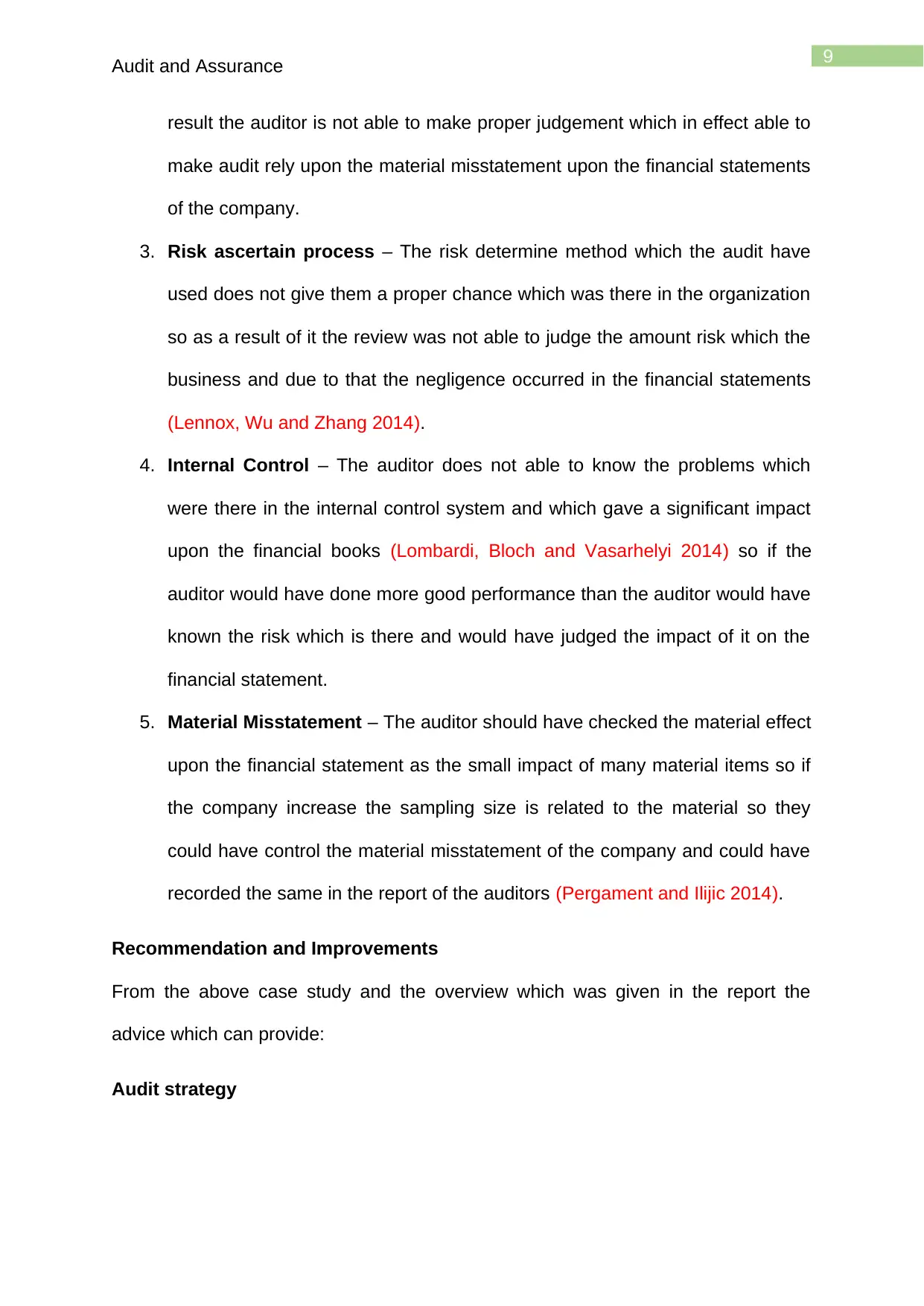
9
Audit and Assurance
result the auditor is not able to make proper judgement which in effect able to
make audit rely upon the material misstatement upon the financial statements
of the company.
3. Risk ascertain process – The risk determine method which the audit have
used does not give them a proper chance which was there in the organization
so as a result of it the review was not able to judge the amount risk which the
business and due to that the negligence occurred in the financial statements
(Lennox, Wu and Zhang 2014).
4. Internal Control – The auditor does not able to know the problems which
were there in the internal control system and which gave a significant impact
upon the financial books (Lombardi, Bloch and Vasarhelyi 2014) so if the
auditor would have done more good performance than the auditor would have
known the risk which is there and would have judged the impact of it on the
financial statement.
5. Material Misstatement – The auditor should have checked the material effect
upon the financial statement as the small impact of many material items so if
the company increase the sampling size is related to the material so they
could have control the material misstatement of the company and could have
recorded the same in the report of the auditors (Pergament and Ilijic 2014).
Recommendation and Improvements
From the above case study and the overview which was given in the report the
advice which can provide:
Audit strategy
Audit and Assurance
result the auditor is not able to make proper judgement which in effect able to
make audit rely upon the material misstatement upon the financial statements
of the company.
3. Risk ascertain process – The risk determine method which the audit have
used does not give them a proper chance which was there in the organization
so as a result of it the review was not able to judge the amount risk which the
business and due to that the negligence occurred in the financial statements
(Lennox, Wu and Zhang 2014).
4. Internal Control – The auditor does not able to know the problems which
were there in the internal control system and which gave a significant impact
upon the financial books (Lombardi, Bloch and Vasarhelyi 2014) so if the
auditor would have done more good performance than the auditor would have
known the risk which is there and would have judged the impact of it on the
financial statement.
5. Material Misstatement – The auditor should have checked the material effect
upon the financial statement as the small impact of many material items so if
the company increase the sampling size is related to the material so they
could have control the material misstatement of the company and could have
recorded the same in the report of the auditors (Pergament and Ilijic 2014).
Recommendation and Improvements
From the above case study and the overview which was given in the report the
advice which can provide:
Audit strategy
Paraphrase This Document
Need a fresh take? Get an instant paraphrase of this document with our AI Paraphraser

10
Audit and Assurance
The auditor should have improved its audit strategy in regards to the
company. It should make an approach taking the business and other factors in to
consideration. As audit strategy involves many parts so the auditor should work
accordingly to all of them. The things which should improve in the audit strategy are:
1. Scope of the Audit – The scope of the audit should be increased by the
company as if it increases the range then it will able to do the inspection more
quickly and accurately and thus it will able to know more about the weakness
and fraud in the company financial statements
2. Engagement letter – It should increase the details in the engagement so that
it can make clearer about the details to the client so that the professional
requirements can be precise and easily communicate with the client.
3. Nature of communication – The auditor should make all its communication
informal so that it can keep all the record of each transaction and can clear all
the discussion related to the audit process.
4. Reporting objectives – The auditor should mention the reporting which it will
check and what are the requirements which the company have to give to the
auditor in time of the audit process.
Audit Program
It is the audit plan which the auditor makes in related to what are the
procedure it will follow to validate that the company is following all the necessary
compliance. So the auditor should increase the plan and should also implement
the changes in regard to the procedure so that it can check the required
documents related to compliances (Pitt 2014.). The plan of the audit based upon
the policies, methods so it should be made clear by the auditor to make the
Audit and Assurance
The auditor should have improved its audit strategy in regards to the
company. It should make an approach taking the business and other factors in to
consideration. As audit strategy involves many parts so the auditor should work
accordingly to all of them. The things which should improve in the audit strategy are:
1. Scope of the Audit – The scope of the audit should be increased by the
company as if it increases the range then it will able to do the inspection more
quickly and accurately and thus it will able to know more about the weakness
and fraud in the company financial statements
2. Engagement letter – It should increase the details in the engagement so that
it can make clearer about the details to the client so that the professional
requirements can be precise and easily communicate with the client.
3. Nature of communication – The auditor should make all its communication
informal so that it can keep all the record of each transaction and can clear all
the discussion related to the audit process.
4. Reporting objectives – The auditor should mention the reporting which it will
check and what are the requirements which the company have to give to the
auditor in time of the audit process.
Audit Program
It is the audit plan which the auditor makes in related to what are the
procedure it will follow to validate that the company is following all the necessary
compliance. So the auditor should increase the plan and should also implement
the changes in regard to the procedure so that it can check the required
documents related to compliances (Pitt 2014.). The plan of the audit based upon
the policies, methods so it should be made clear by the auditor to make the

11
Audit and Assurance
requirement clear regarding the theories about the company. The auditor should
also check the management priorities, business structure, legal forms and what
are the expectations are related to the customers it should check all the details to
make a proper business objective of the company (Pizzini, Lin and Ziegenfuss
2014).
Other Measures which can be taken
The measure which can take is to check whether all the necessary accounting
standard are followed by the company or not. It should check all the accounting
standard to know whether the company is developing or not (Shore and Wright
2015). Then it should whether all the industry norms are followed or not as it will see
the company is following all the standards which are made by the industry in regards
to the company. It should increase the physical verification of the stock and third
party so that it can know the fault which is there in the financial statement and can
make their decision as per the failure. It should also do different questionnaires with
the company employees so that it can know how the company is performing their
business is related to the internal control and able to judge the management
efficiency by that questions (Tepalagul and Lin 2015). It also should take public
interest as a priority while implementing the audit process in the company and also it
should give its opinion taking regards the details of the financial statement and
should be clear about the basic in which the financial books are made by the
company. The auditor should give an independent opinion and should not be biased
with the management decision (William Jr, Glover and Prawitt 2016).
Audit and Assurance
requirement clear regarding the theories about the company. The auditor should
also check the management priorities, business structure, legal forms and what
are the expectations are related to the customers it should check all the details to
make a proper business objective of the company (Pizzini, Lin and Ziegenfuss
2014).
Other Measures which can be taken
The measure which can take is to check whether all the necessary accounting
standard are followed by the company or not. It should check all the accounting
standard to know whether the company is developing or not (Shore and Wright
2015). Then it should whether all the industry norms are followed or not as it will see
the company is following all the standards which are made by the industry in regards
to the company. It should increase the physical verification of the stock and third
party so that it can know the fault which is there in the financial statement and can
make their decision as per the failure. It should also do different questionnaires with
the company employees so that it can know how the company is performing their
business is related to the internal control and able to judge the management
efficiency by that questions (Tepalagul and Lin 2015). It also should take public
interest as a priority while implementing the audit process in the company and also it
should give its opinion taking regards the details of the financial statement and
should be clear about the basic in which the financial books are made by the
company. The auditor should give an independent opinion and should not be biased
with the management decision (William Jr, Glover and Prawitt 2016).
⊘ This is a preview!⊘
Do you want full access?
Subscribe today to unlock all pages.

Trusted by 1+ million students worldwide
1 out of 17
Related Documents
Your All-in-One AI-Powered Toolkit for Academic Success.
+13062052269
info@desklib.com
Available 24*7 on WhatsApp / Email
![[object Object]](/_next/static/media/star-bottom.7253800d.svg)
Unlock your academic potential
Copyright © 2020–2025 A2Z Services. All Rights Reserved. Developed and managed by ZUCOL.





